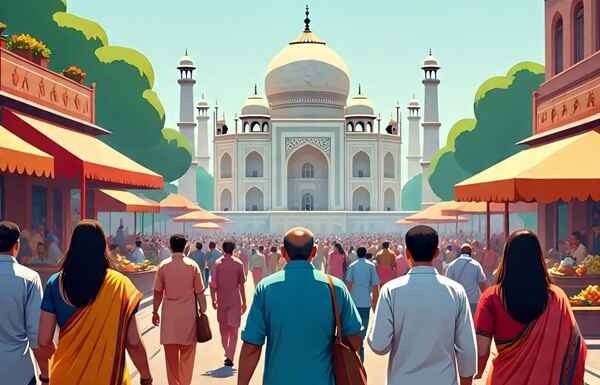It’s true that India finally surpassed China to become the most populated country in the entire world, with as many as 1.46 billion people living here. But the thing is, India actually is only the 7th largest nation by land area, which means the population density is somewhat higher. Though within the borders of India, you’ll see that not all states or areas are equally dense with people living there; there is a huge inequality, and some states are surely much denser than others. And that’s why we’re here with this list of the Top 10 Highest Population Density States In India 2025.

1. Bihar
To start off, Bihar is the most populous state of India. In the year 2025, the state had a population of 130 million people and it is said to cover an area covering 94,163 square kilometers. It turns out that the density of the place in 2025 is approximately 1,390 people per square kilometer. Bihar is made up of a big urban center, and it’s here that the River Ganges flows, thus cutting the state into two. It is, for instance, a case that people under 25 come to approximately 58% and even more, only one in a group of eight individuals resides within the city.
2. West Bengal
Next in the line is West Bengal. It covers a wide area of 88,752 square kilometers, and by 2025, it was inhabited by around 103 million people. That will give a density of about 1,160 people per square kilometer for that year. West Bengal is located in the Bay of Bengal territory, and the capital, Kolkata, is one of the major cities in India. This makes the whole place dense, and the situation is the same even outside the city, with people residing in both village and urban places.
3. Uttar Pradesh
Uttar Pradesh is by far the most populous state in India, with the state being spread across a territory of about 243,286 square kilometers and hosting approximately 241 million inhabitants. The higher number of people would be nearly 1000 persons per square kilometre by the year 2025. Lucknow, the primary place of people’s activities, is situated on the Ganges-Yamuna plains and is a densely populated agricultural area.
4. Kerala
Kerala is a smaller state that lies at just 38,863 square kilometers on the Arabian Sea. Population growth has stagnated; there were 33 million individuals in 2011 and an expectation of 35 million in 2025, still, the space is limited, and the density is around 900 people per square kilometer. Its coastal region runs along the entire state, and its people live long, which ranks Kerala high in the density index.
5. Haryana
The area of Haryana is 44,212 square kilometers, with an expected population of about 31 million people by 2025. It accounts for approximately 700 persons per square kilometer. The state of Chandigarh is the shared capital of Punjab as well as Haryana, and also Haryana state shares it. It includes more than one National Capital Region, namely cities like Gurgaon and Faridabad.
6. Punjab
Punjab is spread across 50,362 square kilometers of prosperous plains and is expected to have around 32 million inhabitants by the middle of 2025. This means that, approximately, there will be a population of 640 for each square kilometer. Areas like Chandigarh, where the main cities are located, and Ludhiana, the center of industrial activity, are the focal points of urban development, and these areas are the main contributors to the rise of the population density of the region.
7. Tamil Nadu
Tamil Nadu is a 130,058 square kilometers Indian state, occupying the south-eastern coast. By 2025, the population in the state is going to be around 78 million and the population density will be about 600 people per square kilometer. The city of Chennai is a huge city, while the industrial corridor is formed by Coimbatore and Salem, among other places.
8. Jharkhand
Jharkhand came into existence as a separate state from Bihar in the year 2000. The state is occupying an area of 79,714 square kilometers that is mostly covered with forests and has abundant mineral resources. It is estimated that by 2025, the number of inhabitants will be around 40 million, which will make its population density 500 people per square kilometer.
9. Assam
Assam lies across 78,438 square kilometers of the Brahmaputra valley, and by 2025, the state will host about 36 million inhabitants. That’s about 460 people living per square kilometer. Guwahati is northeast India’s most populous city, and there are also tea-garden towns contributing to the region’s urban landscape. However, the heavy rains in the monsoon season narrow the habitable space, thus people are squeezed onto the few raised parts of the land, which makes it much more crammed.
10. Karnataka
Karnataka is a vast state and occupies 191,791 square kilometers, with 70 million potential residents forecasted for the year 2025. That will make the density of people the least among all states in India, slightly above 360. The population of Bengaluru has been rapidly growing in recent years, causing the population in cities to rise. Meanwhile, extremely big spaces like the Western Ghats and the northern plateau, which are not so densely populated, keep the average to a lower level.
Conclusion
In other words, these states are so densely populated that in just these ten states, there are as many as 800 million people living, and this number is only growing further. That is more than 55% of the population actually.